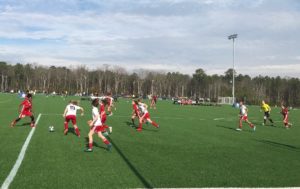In every market where there’s a major change, there’s a tipping point when consumers decide they no longer want to buy into what is currently being offered – even if those offerings have been around for some time. The turf infill industry may be ready for its own tipping point.
Greenplay and our founder, Domenic Carapella, were recently featured in an article on plant-based infill in the turf market for a publication called Athletic Business. If you haven’t had a chance to read the article yet, we would highly encourage you to check it out and see what the latest trend is in the synthetic turf market.
The trade magazine is a must-read for individuals in colleges and universities, high schools, park and recreation departments, military branches and bases, health clubs, YMCAs, professional sports teams, stadiums and arenas, sports architecture firms, and hospital and corporate wellness centers. Overall, there are 40,000 subscribers of the magazine as well as tens of thousands visitors to its online site.
Paul Steinbach wrote the piece, and he looked at the growing popularity of plant-based infill and why more readers of Athletic Business may be looking for alternatives to crumb rubber. The truth is that crumb rubber infill presents many issues. One infill supplier remarked how crumb rubber is hot, dusty, and smells. Plus, there have been some studies linking it to heat-related injuries and potential exposure to carcinogens.
Yet, crumb rubber is still used on a great majority of synthetic turf fields. Some estimate that it could be as much as 12,000 fields. Sure, crumb rubber is cheap, but there are way too many negatives to justify the number of synthetic fields that still have turf infill.
When Domenic Carapella was interviewed about plant-based turf infill, he was quick to point out that the market has grown exponentially in just three years. In the past 30 months, he said that Greenplay has supplied more than 60 fields. That’s significantly more than Carapella had supplied in the previous ten years. Carapella says the public wants alternatives and is driving the change towards natural infill.
Greenplay’s organic infill is made from sustainable plant-based materials that offer customers the best overall safety options. Greenplay’s turf infill features comparable field temperatures to grass, low Gmax ratings to reduce the threat of significant injury, enhanced foot stability, low abrasion, and more.
Although there is a long way to go before plant-based turf infill becomes the standard, the enthusiasm for alternatives to rubber crumb indicates we will eventually get there.
It started with a vision of Greenwood Park, Henrico County, Va. becoming a sports complex so outstanding that it would attract athletic teams from all over the county as well as accommodate local schools. Voters overwhelmingly approved plans and were assured that their health and safety would be the fundamental factor when choosing what products to utilize.
Due diligence began with research in order to select those products that would create the safest synthetic turf system for the athletic destination that would be Greenwood Park. It did not take long for a decisions to be made. Greenplay’s Corkonut® was chosen as the organic turf infill along with Brock’s PowerBase YSR pad to keep field surface temperatures low and to protect athletes from concussions and other sports related injuries.
Greenplay’s Corkonut® is a proven blend of coconut fiber and cork that better integrates with the natural environment. It is successfully installed in well over 50 fields across the nation including these four new state-of-the-art synthetic turf fields now open at Greenwood Park.

The Ultimate Cup soccer tournament was held on the opening weekend of February 24th and for some, it was a first-time amazing experience playing on a field with Corkonut. “The response to the Corkonut® infill at Greenwood Park has been nothing but positive. I spoke with a family on opening day after an elite-level soccer game, and the parents were thrilled. ‘Our daughter is a keeper and she didn’t get torn up.’ That’s why Henrico chose to go organic . . . player safety.” -Dawn Miller, Tourism Supervisor of Henrico County Division of Recreation and Parks.
The vision Henrico County had for their community has become a successful reality as athletes and families from near and far are enjoying the safest state-of-the-art synthetic turf fields. It won’t be long before the local high schools each get their own new field installed with Greenplay’s Corkonut turf infill. Stay tuned.